Emas are the uniquely Japanese wooden plaques that
Shinto devotees use for the communication of their devotion or their wishes
to their Kami. Generally cut in an elongated but symmetrical pentagonal shape
from thin slabs of pine or cedar, they come imprinted with a relevant image
and, before being hung in a suitable spot in the devotee's shrine (Jinja),
may be inscribed with an appropriate personal message.
We include a selection of Emas on this page. Click on
any one of them to see an enlarged version in a new window. You may then
cycle through the enlarged versions; or, just return to this page via the grayblue
|×| button
centered below the image.
Links to some Emas from Izumo, and other Materia Japonica,
are to be found at the bottom of this page.
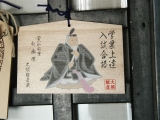 |
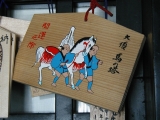 |
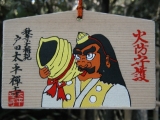 |
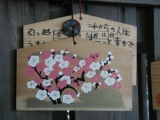 |
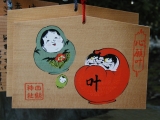 |
| 1. “Tsuna shiki
Tenjin”. Portrait of Sugawara Michizane (Tenjin) sitting on a coil of rope.
Osu Kan-non (Buddhist) Temple, Nagoya. |
2. A pure white horse for the Gods,
Osu Kan-non (Buddhist) Temple, Nagoya. A Kai-un (good luck ema), often
left by New Year’s visitors who wish to turn their luck around in the coming
year. |
3. The Tengu Akiba Sanjaku Bo, guardian
against fire, blowing on a conch shell. Atsuta Jingu, Nagoya. |
4. Plum flowers, symbol of Tenjin (cf. Ema 1).
Atsuta Jingu, Nagoya. |
5. Family of Daruma (from Dharma, a.k.a. Damo,
the Indian Buddhist priest Bodhidharma, introducer of Zen Buddhism to China).
Tagata Jinja, Komaki city, northern outskirts of Nagoya. |
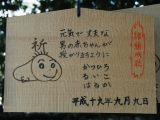 |
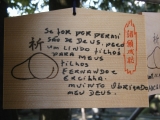 |
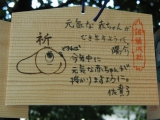 |
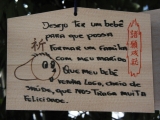 |
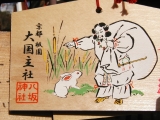 |
6, 7, 8, 9. Fertility
Emas at Tagata Jinja, outside Nagoya,
bearing wishes, in both Japanese and Portuguese,
for successful conceptions:
6. ...a vigorous, healthy baby boy...;
7. ...a son for my sons...; 8. ...to conceive a healthy baby...; 9. ...a baby
to start a family... . |
10. Opokuninushi and the
White Rabbit of Inaba. Yasaka Jinja, Kyoto. |
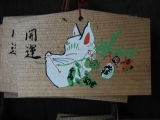 |
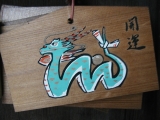 |
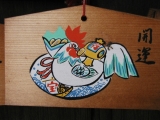 |
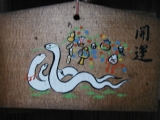 |
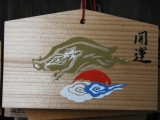 |
| 11. Kai-un (cf. Ema 2)
with head of a fox (fox = fortune-messenger of Inari) and Kanji messages for
much money — Sen-ryo (1,000 ryo), Man-ryo (10,000 ryo) — and
Dai-Fuku (great happiness). (Ryo is the old Japanese
monetary unit.) Yasaka Jinja, Kyoto. |
12. Kai-un for the Year of the
Dragon (2000), Yasaka Jinja, Kyoto. Note the fortune slip tied to the
dragon’s tail. |
13. Kai-un for the Year of the
Rooster (2005), Yasaka Jinja, Kyoto. Note the accompanying Treasure bag and
Fortune hammer. |
14. Kai-un for the Year of the
Snake (2001), Yasaka Jinja, Kyoto. Snakes are also the fortune messengers
of the Goddess Benzai-ten. |
15. Boar leaping over sun and clouds. Kai-un
for the Year of the Boar (2007), Yasaka Jinja, Kyoto. |
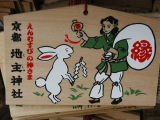 |
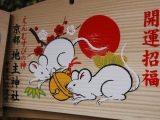 |
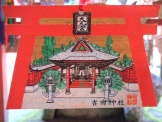 |
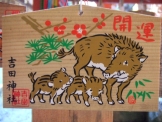 |
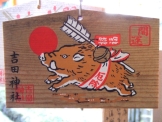 |
16. Opokuninushi (with
Treaure bag and Fortune hammer) and the
White Rabbit of Inaba. Jishu Jinja,
Kiyomizudera Temple, Kyoto. |
17. Kai-un for the Year of the Mouse (2008),
Jishu Jinja, Kiyomizudera Temple, Kyoto. The plum flower, bamboo, and pine tree
are symbols of happiness. |
18. Ema depicting the unique octagonal
shrine Daigen Kyu (builder: Yoshida Kanetomo, 1435-1511), framed under its Torii
gateway arch. Yoshida Jinja, Kyoto. |
19. Mother Boar with two sucklings.
Kai-un for the Year of the Boar (2007),
Yoshida Jinja, Kyoto. |
20. Kai-un for the Year of the Boar (2007),
Yoshida Jinja, Kyoto. Kanji, in part: “Sho-Fuku”
(invite happiness). |
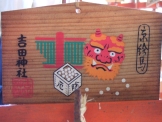 |
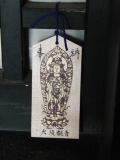 |
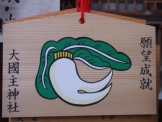 |
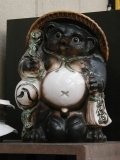 |
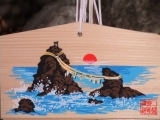 |
21. Oni (Japanese
demon), cast out by soybeans, Yoshida Jinja, Kyoto.
Recalls the annual
Setsubun Festival (February 3) “Mame maki” (bean-throwing) tradition,
in which a handful of soybeans is cast within one's quarters while saying
“Fuku-wa-uchi!” (Happiness hither!), and another is cast
outside to the words “Oni-wa-soto!” (Demon out!).
In Kanji on the box: “Expel Oni.” |
23. Forked Japanese Daikon
(huge white radish,
symbol of Dai Koku = O-Kuni-Nushi),
O-Kuni-Nushi
Jinja, Osaka.
The
Daikon-boiling Festival at Kyoto’s Senbon Shaka-do Temple,
early each December, serves up bowl upon bowl of a deliciously
steamy Daikon Soup, or “O-den”. |
25. The Wedded Rocks (Meoto
Iwa). Futami Okitama Jinja, Futami no Ura station, near Ise. |
22. An unusual vertical
Ema, portraying a Buddhist bronze of Kan-non (Avalokitesvara),
Osu Kan-non
(Buddhist) Temple, Nagoya. |
24. Tanuki: not an Ema at all, but
the
beloved Badger figurine. Near Osu Kan-non Temple, Nagoya. |
























